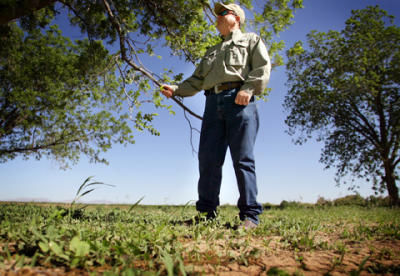
As of today, soon just stretched out a little further.
The Greater El Paso area today will hit a record-breaking 110 consecutive days without a trace of rain. According to the National Weather Service office in Santa Teresa, the old record was 109 days in 2002.
If you're looking for a drop of hope this week, then forecasts through Friday will disappoint you.
The National Weather Service is predicting dusty, sunny and windy conditions through the Memorial Day weekend. Daytime temperatures will range between the high 80s to low 90s; nighttime temperatures will hover around the mid 60s.
Effects from this year's drought are already being felt as farmers prepare for lower crop yields next year.
The problem lies in a lack of precipitation that eventually streams through the Rio Grande and into the Elephant Butte Reservoir.
El Paso County farmers welcome water that flows down from the Rocky Mountains in Colorado and northern New Mexico. Most of that water comes from melting snowpack. In the past couple of years, the Rockies' snowpack has been very poor, resulting in low lake levels farther south.
At the moment, Elephant Butte Lake, which can hold up to 2.5 million acre-feet of water, is only 16 to 17 percent full.
Kevin Ivey, a third-generation El Paso County farmer, is one of several farmers dependent on the Colorado runoff.
He uses it each year to irrigate his crops of alfalfa and cotton and his pecan orchards.
All three normally yield him enough income to provide for his family of six.
But now, if the drought doesn't break soon, the family will have to start cutting back.
"This year it's like, right now, we're getting sunburned," Ivey said. "And next year will be like at night when the sunburn hurts. Unless something changes next year, it will be bad."
When water levels are low, farmers turn to using wells and aquifers filled from unused water from previous years for help.
At the moment, farmers are receiving full allocations from reserves that are 4 acre-feet of water per acre of land. An acre-foot of water can supply the household needs of two four-person families for one year.
But if water doesn't trickle down from the Rocky Mountains soon, farmers are told to expect cutbacks of 3.5 acre-feet per acre this year.
"Unless we get a big rainstorm and we have a good summer, then the city will have to help with the water conservation," said Chuy Reyes, general manager of El Paso County Water Improvement District 1. "And it may reach the point similar to what we saw during the February winter storm."
Today's conditions are reminiscent of the drought of the 1950s, said Jim Ivey, Kevin Ivey's father. During that time, area farmers struggled to grow crops and maintain their lifestyle for a decade.
"It was one of the longest droughts we had had," Jim Ivey said. "Without any snowfall in the canals that flowed from the Rio Grande, everyone in the Lower Valley, Juárez Valley and Upper Valley suffered."
To get through those harsh years, local farmers drilled wells and ran piping underground from one well to the next. And Kevin Ivey said his operation might have to do that next year.
Yet to repair a well or buy a new one can cost more than $6,000. Another downside to this solution: Water from the underground reservoirs is saltier.
Too much salt in the water can kill the plants, cutting off the farmers' source of income. To offset this, farmers may have to add sulfuric acid to the irrigation water -- a dangerous practice. Too much sulfuric acid can ultimately burn and damage crops. Another option involves consolidating one crop for another.
But if farmers consolidate their crops, then costs may go up at grocery stores.
One crop that some farmers may consolidate is alfalfa. If there is less alfalfa, then less hay will go to dairies. When there's less hay for feed, the price of hay is driven up and the cost of milk jumps. The domino effect continues at dairy farms which may, in turn, keep fewer cattle and thereby produce less dairy and meat products -- driving up demand and prices for consumers.
Local farmers don't want that to occur.
"We just pray it snows in Colorado," Jim Ivey said, "and we need that snow to rush down. If it simply melts, then it can just get soaked into the ground."
Reyes said it may take a community effort to get by next year.
"We all need to keep our eyes on how people are using their water and make sure that park water isn't being abused," Reyes said. "It takes an effort from all of us."



Reader Comments
to our Newsletter